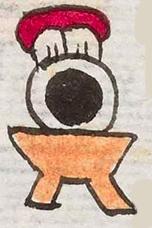Mollanco (Mdz13r)
This compound glyph for the place name Mollanco, features three prominent visual elements, a frontal view of a sauce (molli) bowl the color of terracotta (so, probably ceramic), a cross-section of a black rubber (olli) ball with a white ring around it, and two front teeth (tlantli), white with red gums. The bowl has two visible legs, but there was probably a third in the back. The locative suffix (-co) is not shown visually. Note the other compound glyphs from the Codex Mendoza, which are varied (below, right).
Stephanie Wood
The rubber does not appear to have a semantic contribution, just a phonetic one. The rubber element "ol" (the combining form of olli, rubber) phonetically reinforces part of the the "mol" sound from the verb mola. The "tlan" plays a phonetic role, too, not being about teeth but suggesting the locative for near. When -tlan- combines with the "mol," the result is the double l, and the t drops away. This explains the doubling of the l in normalizing the spelling of the place name in the gloss. The final meaning could be a town famous for grinding things as Karttunen suggests. Perhaps the town made molcajetes (sauce bowls, using the Mexican Spanish term for molcaxitl here).
Karttunen concludes that the three elements of this glyph would work better for a place name "Molotla," and that would return the locative role to the tooth glyph. We do have a compound glyph for the place name "Molotla" (or possibly meant to be Molotlan) in this collection. In that case, the glyph refers to the place of the house finch.
In his study of the history in the Codex Chimalpopoca, John Bierhorst (1992, 190) notes that Mollanco was a town that paid tribute to Tetzcoco and perhaps also performed labor for Mexico City. It may have been conquered by Ahuitzotzin. Two towns with the Hispanized place name, Molango, are found today in Hidalgo (near Metztitlan) and in Veracruz.
Stephanie Wood
molanco. puo
Mollanco, pueblo
Stephanie Wood
c. 1541, or by 1553 at the latest
Stephanie Wood
sauces, moles, molcajetes, teeth, dientes, rubber, hule, nombres de lugares

mola, to grind, https://nahuatl.wired-humanities.org/content/mola
mol(li), sauce, https://nahuatl.wired-humanities.org/content/molli
molcaxi(tl), sauce bowl, https://nahuatl.wired-humanities.org/content/molcaxitl
ol(li), rubber, https://nahuatl.wired-humanities.org/content/olli
tlan(tli), tooth/teeth, https://nahuatl.wired-humanities.org/content/tlantli
-tlan, by, near, among, https://nahuatl.wired-humanities.org/content/tlan
"At Mōllān" or "At the Grinding Place" [Frances Karttunen, unpublished manuscript, used here with her permission.]
"In the Place of Many Rubber Bowls" (Berdan and Anawalt, 1992, vol. 1, p. 193)
"El Lugar del Mole" o "El Lugar del Molcajete" o "El Lugar para Moler"
Stephanie Wood
Codex Mendoza, folio 13 recto, https://digital.bodleian.ox.ac.uk/objects/2fea788e-2aa2-4f08-b6d9-648c00..., image 36 of 188.
The Bodleian Libraries, University of Oxford, hold the original manuscript, the MS. Arch. Selden. A. 1. This image is published here under the UK Creative Commons, “Attribution-NonCommercial-ShareAlike 3.0 License” (CC-BY-NC-SA 3.0).









